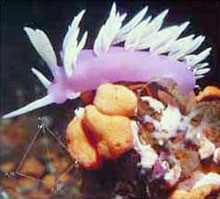Spencer, H. G., & Paul, D. B. (2022). In memoriam: Richard Charles Lewontin (1929–2021): A self-critical critic. American Naturalist, 200(5), 621-626. doi: 10.1086/721258
Journal - Research Other
Smith, A. M., Peebles, B. A., & Spencer, H. G. (2023). Directly observed images through the shell-lenses of Onithochiton neglectus (Mollusca: Polyplacophora: Chitonidae). Molluscan Research, 43(1), 4-11. doi: 10.1080/13235818.2022.2144089
Journal - Research Article
Greenspoon, P. B., Spencer, H. G., & M’Gonigle, L. K. (2022). Epigenetic induction may speed up or slow down speciation with gene flow. Evolution, 76(6), 1170-1182. doi: 10.1111/evo.14494
Journal - Research Article
Rosenfeld, S., Maturana, C. S., Spencer, H. G., Convey, P., Saucède, T., Brickle, P., … Gonzalez-Wevar, C. (2022). Complete distribution of the genus Laevilitorina (Littorinimorpha, Littorinidae) in the Southern Hemisphere: Remarks and natural history [Data paper]. ZooKeys, 1127, 61-77. doi: 10.3897/zookeys.1127.91310
Journal - Research Other
Rawlence, N. J., Salis, A. T., Spencer, H. G., Waters, J. M., Scarsbrook, L., Mitchell, K. J., … Dutoit, L., King, T. M., … Kennedy, M. (2022). Rapid radiation of Southern Ocean shags in response to receding sea ice. Journal of Biogeography, 49, 942-953. doi: 10.1111/jbi.14360
Journal - Research Article
González-Wevar, C. A., Segovia, N. I., Rosenfeld, S., Maturana, C. S., Jeldres, V., Pinochet, R., … Spencer, H. G., & Poulin, E. (2022). Seven snail species hidden in one: Biogeographic diversity in an apparently widespread periwinkle in the Southern Ocean. Journal of Biogeography, 49, 1521-1534. doi: 10.1111/jbi.14453
Journal - Research Article
Spencer, H. G., Willan, R. C., Mariottini, P., & Salvi, D. (2022). Taxonomic consistency and nomenclatural rules within oysters: Comment on Li et al. (2021). Molecular Phylogenetics & Evolution, 170, 107437. doi: 10.1016/j.ympev.2022.107437
Journal - Research Other
Greenspoon, P. B., & Spencer, H. G. (2021). Avoiding extinction under nonlinear environmental change: Models of evolutionary rescue with plasticity. Biology Letters, 17(12), 20210459. doi: 10.1098/rsbl.2021.0459
Journal - Research Article
Whigham, P. A., & Spencer, H. G. (2021). Graph-structured populations and the Hill-Robertson effect. Royal Society Open Science, 8, 201831. doi: 10.1098/rsos.201831
Journal - Research Article
González-Wevar, C. A., Segovia, N. I., Rosenfeld, S., Noll, D., Maturana, C. S., Hüne, M., … Spencer, H. G., … Poulin, E. (2021). Contrasting biogeographical patterns in Margarella (Gastropoda: Calliostomatidae: Margarellinae) across the Antarctic Polar Front. Molecular Phylogenetics & Evolution, 156, 107039. doi: 10.1016/j.ympev.2020.107039
Journal - Research Article
Lockton, K. G., & Spencer, H. G. (2021). Phylogeography of the intertidal marine bivalve Lasaea hinemoa (Mollusca: Bivalvia) in New Zealand. Molluscan Research, 41(3), 191-203. doi: 10.1080/13235818.2021.1966163
Journal - Research Article
Spencer, H. G. (2021). [Review of the book Biology and evolution of the mollusca]. Molluscan Research, 41(1), 80-82. doi: 10.1080/13235818.2020.1859344
Journal - Research Other
Spencer, H. G. (2020). Beyond equilibria: The neglected role of history in ecology and evolution. Quarterly Review of Biology, 95(4), 311-321. doi: 10.1086/711803
Journal - Research Article
Zuk, M., & Spencer, H. G. (2020). Killing the behavioral zombie: Genes, evolution, and why behavior isn't special. BioScience, 70(6), 515-520. doi: 10.1093/biosci/biaa042
Journal - Research Article
Donald, K. M., McCulloch, G. A., Dutoit, L., & Spencer, H. G. (2020). Population structure of the New Zealand whelk, Cominella glandiformis (Gastropoda: Buccinidae), suggests sporadic dispersal of a direct developer. Biological Journal of the Linnean Society, 130, 49-60. doi: 10.1093/biolinnean/blaa033
Journal - Research Article
Spencer, H. G. (2020). A further perspective on speciation by reinforcement. Theoretical Biology Forum, 113(1/2), 63-66. doi: 10.19272/202011402007
Journal - Research Article
Brook, F. J., Kennedy, M., King, T. M., Ridden, J., Shaw, M. D., & Spencer, H. G. (2020). Catalogue of New Zealand land, freshwater and estuarine molluscan taxa named by Frederick Wollaston Hutton between 1879 and 1904. Zootaxa, 4865(1), 1-73. doi: 10.11646/zootaxa.4865.1.1
Journal - Research Article
Jeunen, G.-J., Lamare, M. D., Knapp, M., Spencer, H. G., Taylor, H. R., Stat, M., … Gemmell, N. J. (2020). Water stratification in the marine biome restricts vertical environmental DNA (eDNA) signal dispersal. Environmental DNA, 2(1), 99-111. doi: 10.1002/edn3.49
Journal - Research Article
Kennedy, M., Seneviratne, S. S., Rawlence, N. J., Ratnayake, S., & Spencer, H. G. (2019). The phylogenetic placement of the enigmatic Indian Cormorant, Phalacrocorax fuscicollis (Phalacrocoracidae). Molecular Phylogenetics & Evolution, 130, 227-232. doi: 10.1016/j.ympev.2018.10.019
Journal - Research Article
Kennedy, M., Seneviratne, S. S., Mendis, U. K., & Spencer, H. G. (2019). Sorting out the snakebirds: The species status, phylogeny, and biogeography of the Darters (Aves: Anhingidae). Journal of Zoological Systematics & Evolutionary Research, 57, 892-899. doi: 10.1111/jzs.12299
Journal - Research Article
González-Wevar, C. A., Hüne, M., Rosenfeld, S., Nakano, T., Saucède, T., Spencer, H., & Poulin, E. (2019). Systematic revision of Nacella (Patellogastropoda: Nacellidae) based on a complete phylogeny of the genus, with the description of a new species from the southern tip of South America. Zoological Journal of the Linnean Society, 186(2), 303-336. doi: 10.1093/zoolinnean/zly067
Journal - Research Article
Rawlence, N. J., Rayner, M. J., Lovegrove, T. G., Stoddart, D., Vermeulen, M., Easton, L. J., … Kennedy, M., Spencer, H., & Waters, J. M. (2019). Archival DNA reveals cryptic biodiversity within the Spotted Shag (Phalacrocorax punctatus) from New Zealand. Condor, 121, 1-16. doi: 10.1093/condor/duz029
Journal - Research Article
Jeunen, G.-J., Knapp, M., Spencer, H. G., Taylor, H. R., Lamare, M. D., Stat, M., … Gemmell, N. J. (2019). Species‐level biodiversity assessment using marine environmental DNA metabarcoding requires protocol optimization and standardization. Ecology & Evolution, 9, 1323-1335. doi: 10.1002/ece3.4843
Journal - Research Article
Jeunen, G.-J., Knapp, M., Spencer, H. G., Lamare, M. D., Taylor, H. R., Stat, M., … Gemmell, N. J. (2019). Environmental DNA (eDNA) metabarcoding reveals strong discrimination among diverse marine habitats connected by water movement. Molecular Ecology Resources, 19, 426-438. doi: 10.1111/1755-0998.12982
Journal - Research Article
Paul, D. B., Stenhouse, J., & Spencer, H. G. (Eds.). (2018). Eugenics at the edges of empire: New Zealand, Australia, Canada and South Africa. Cham, Switzerland: Palgrave MacMillan, 320p. doi: 10.1007/978-3-319-64686-2
Edited Book - Research
Spencer, H. G. (2018). Eugenic sterilization in New Zealand: The story of the Mental Defectives Amendment Act of 1928. In D. B. Paul, J. Stenhouse & H. G. Spencer (Eds.), Eugenics at the edges of empire: New Zealand, Australia, Canada and South Africa. (pp. 85-106). Cham, Switzerland: Palgrave MacMillan. doi: 10.1007/978-3-319-64686-2
Chapter in Book - Research
Greenspoon, P. B., & Spencer, H. G. (2018). The evolution of epigenetically-mediated adaptive transgenerational plasticity in a subdivided population. Evolution, 72(12), 2773-2780. doi: 10.1111/evo.13619
Journal - Research Article
González-Wevar, C. A., Segovia, N. I., Rosenfeld, S., Ojeda, J., Hüne, M., Naretto, J., … Spencer, H. G., & Poulin, E. (2018). Unexpected absence of island endemics: Long-distance dispersal in higher latitude sub-Antarctic Siphonaria (Gastropoda: Euthyneura) species. Journal of Biogeography, 45(4), 874-884. doi: 10.1111/jbi.13174
Journal - Research Article
Kelly, S. T., & Spencer, H. G. (2017). Population-genetic models of sex-limited genomic imprinting. Theoretical Population Biology, 115, 35-44. doi: 10.1016/j.tpb.2017.03.004
Journal - Research Article
González-Wevar, C. A., Hüne, M., Segovia, N. I., Nakano, T., Spencer, H. G., Chown, S. L., … Poulin, E. (2017). Following the Antarctic Circumpolar Current: Patterns and processes in the biogeography of the limpet Nacella (Mollusca: Patellogastropoda) across the Southern Ocean. Journal of Biogeography, 44(4), 861-874. doi: 10.1111/jbi.12908
Journal - Research Article
Peebles, B. A., Smith, A. M., & Spencer, H. G. (2017). Valve microstructure and phylomineralogy of New Zealand chitons. Journal of Structural Biology, 197(3), 250-259. doi: 10.1016/j.jsb.2016.12.002
Journal - Research Article
Rawlence, N. J., Till, C. E., Easton, L. J., Spencer, H. G., Schuckard, R., Melville, D. S., … Waters, J. M., & Kennedy, M. (2017). Speciation, range contraction and extinction in the endemic New Zealand King Shag complex. Molecular Phylogenetics & Evolution, 115, 197-209. doi: 10.1016/j.ympev.2017.07.011
Journal - Research Article
Spencer, H. G., & Priest, N. K. (2016). The evolution of sex-specific dominance in response to sexually antagonistic selection. American Naturalist, 187(5), 658-666. doi: 10.1086/685827
Journal - Research Article
Spencer, H. G., & Mitchell, C. (2016). The selective maintenance of allelic variation under generalized dominance. Genes Genomes Genetics, 6(11), 3725-3732. doi: 10.1534/g3.116.028076
Journal - Research Article
Spencer, H. G., & Zuk, M. (2016). For host's sake: The pluses of parasite preservation [Forum]. Trends in Ecology & Evolution, 31(5), 341-343. doi: 10.1016/j.tree.2016.02.021
Journal - Research Other
Paul, D. B., & Spencer, H. G. (2016). Eugenics without eugenists? Anglo-American critiques of cousin marriages in the nineteenth and early twentieth centuries. In S. Müller-Wille & C. Brandt (Eds.), Heredity explored: Between public domain and experimental science, 1850-1930. (pp. 49-79). Cambridge, MA: MIT Press.
Chapter in Book - Research
Donald, K. M., & Spencer, H. G. (2016). Phylogeographic patterns in New Zealand and temperate Australian cantharidines (Mollusca: Gastropoda: Trochidae: Cantharidinae): Trans-Tasman divergences are ancient. Molecular Phylogenetics & Evolution, 100, 333-344. doi: 10.1016/j.ympev.2016.04.029
Journal - Research Article
Rawlence, N. J., Scofield, R. P., Spencer, H. G., Lalas, C., Easton, L. J., Tennyson, A. J. D., … Waters, J. M., & Kennedy, M. (2016). Genetic and morphological evidence for two species of Leucocarbo shag (Aves, Pelecaniformes, Phalacrocoracidae) from southern South Island of New Zealand. Zoological Journal of the Linnean Society, 177(3), 676-694. doi: 10.1111/zoj.12376
Journal - Research Article
Donald, K. M., & Spencer, H. G. (2016). Host and ecology both play a role in shaping distribution of digenean parasites of New Zealand whelks (Gastropoda: Buccinidae: Cominella). Parasitology, 143(9), 1143-1156. doi: 10.1017/S0031182016000494
Journal - Research Article
Cumming, R. A., Nikula, R., Spencer, H. G., & Waters, J. M. (2016). Trans-Tasman genetic connectivity in the intertidal air-breathing slug Onchidella nigricans. Marine Ecology Progress Series, 562, 93-100. doi: 10.3354/meps11926
Journal - Research Article
Smith, A. M., & Spencer, H. G. (2016). Skeletal mineralogy of scaphopods: An unusual uniformity. Journal of Molluscan Studies, 82(2), 344-348. doi: 10.1093/mollus/eyv061
Journal - Research Article
Donald, K. M., Winter, D. J., Ashcroft, A. L., & Spencer, H. G. (2015). Phylogeography of the whelk genus Cominella (Gastropoda: Buccinidae) suggests long-distance counter-current dispersal of a direct developer. Biological Journal of the Linnean Society, 115(2), 315-332. doi: 10.1111/bij.12529
Journal - Research Article
Spencer, H. G., & Chiew, K. X. (2015). The maintenance of single-locus polymorphism by maternal selection. Genes Genomes Genetics, 5, 963-969. doi: 10.1534/g3.115.017392
Journal - Research Article
Donald, K. M., & Spencer, H. G. (2015). New Zealand screw shells Maoricolpus roseus (Gastropoda: Turritellidae): Two species, two subspecies or a single variable species? Molluscan Research, 35(2), 123-127. doi: 10.1080/13235818.2014.977838
Journal - Research Article
Spencer, H. G., & Clark, A. G. (2014). Non-conflict theories for the evolution of genomic imprinting. Heredity, 113, 112-118. doi: 10.1038/hdy.2013.129
Journal - Research Article
Herman, J. J., Spencer, H. G., Donohue, K., & Sultan, S. E. (2014). How stable 'should' epigenetic modifications be? Insights from adaptive plasticity and bet hedging. Evolution, 68(3), 632-643. doi: 10.1111/evo.12324
Journal - Research Article
Kennedy, M., & Spencer, H. G. (2014). Classification of the cormorants of the world. Molecular Phylogenetics & Evolution, 79, 249-257. doi: 10.1016/j.ympev.2014.06.020
Journal - Research Article
Rawlence, N. J., Till, C. E., Scofield, R. P., Tennyson, A. J. D., Collins, C. J., Lalas, C., … Matisoo-Smith, E., Waters, J. M., Spencer, H. G., & Kennedy, M. (2014). Strong phylogeographic structure in a sedentary seabird, the Stewart Island Shag (Leucocarbo chalconotus). PLoS ONE, 9(3), e90769. doi: 10.1371/journal.pone.0090769
Journal - Research Article
Cumming, R. A., Nikula, R., Spencer, H. G., & Waters, J. M. (2014). Transoceanic genetic similarities of kelp-associated sea slug populations: Long-distance dispersal via rafting? Journal of Biogeography, 41, 2357-2370. doi: 10.1111/jbi.12376
Journal - Research Article
Geoghegan, J. L., & Spencer, H. G. (2013). Exploring epiallele stability in a population-epigenetic model. Theoretical Population Biology, 83, 136-144. doi: 10.1016/j.tpb.2012.09.001
Journal - Research Article
Paul, D. B., Stenhouse, J., & Spencer, H. G. (2013). The two faces of Robert FitzRoy, captain of HMS Beagle and governor of New Zealand. Quarterly Review of Biology, 88(3), 219-225. doi: 10.1086/671485
Journal - Research Article
Trotter, M. V., & Spencer, H. G. (2013). Models of frequency-dependent selection with mutation from parental alleles. Genetics, 195(1), 231-242. doi: 10.1534/genetics.113.152496
Journal - Research Article
Star, B., & Spencer, H. G. (2013). Effects of genetic drift and gene flow on the selective maintenance of genetic variation. Genetics, 194, 235-244. doi: 10.1534/genetics.113.149781
Journal - Research Article
Geoghegan, J. L., & Spencer, H. G. (2013). The evolutionary potential of paramutation: A population-epigenetic model. Theoretical Population Biology, 88, 9-19. doi: 10.1016/j.tpb.2013.05.003
Journal - Research Article
Geoghegan, J. L., & Spencer, H. G. (2013). The adaptive invasion of epialleles in a heterogeneous environment. Theoretical Population Biology, 88, 1-8. doi: 10.1016/j.tpb.2013.05.001
Journal - Research Article
Nikula, R., Spencer, H. G., & Waters, J. M. (2013). Passive rafting is a powerful driver of transoceanic gene flow. Biology Letters, 9(1), 20120821. doi: 10.1098/rsbl.2012.0821
Journal - Research Article
Marshall, B. A., & Spencer, H. G. (2013). Comments on some taxonomic changes affecting marine Bivalvia of the New Zealand region recently introduced in Huber's Compendium of bivalves, with some additional taxonomic changes. Molluscan Research, 33(1), 40-49. doi: 10.1080/13235818.2012.754147
Journal - Research Article
Waters, J. M., Trewick, S. A., Paterson, A. M., Spencer, H. G., Kennedy, M., Craw, D., Burridge, C. P., & Wallis, G. P. (2013). Biogeography off the tracks. Systematic Biology, 62(3), 494-498. doi: 10.1093/sysbio/syt013
Journal - Research Article
Kennedy, M., Taylor, S. A., Nádvorník, P., & Spencer, H. G. (2013). The phylogenetic relationships of the extant pelicans inferred from DNA sequence data. Molecular Phylogenetics & Evolution, 66(1), 215-222. doi: 10.1016/j.ympev.2012.09.034
Journal - Research Article
Fraser, C. I., Zuccarello, G. C., Spencer, H. G., Salvatore, L. C., Garcia, G. R., & Waters, J. M. (2013). Genetic affinities between trans-oceanic populations of non-buoyant macroalgae in the high latitudes of the Southern Hemisphere. PLoS ONE, 8(7), e69138. doi: 10.1371/journal.pone.0069138
Journal - Research Article
Nakagawa, S., Lagisz, M., Hector, K. L., & Spencer, H. G. (2012). Comparative and meta-analytic insights into life extension via dietary restriction. Aging Cell, 11(3), 401-409. doi: 10.1111/j.1474-9726.2012.00798.x
Journal - Research Article
Geoghegan, J. L., & Spencer, H. G. (2012). Population-epigenetic models of selection. Theoretical Population Biology, 81(3), 232-242. doi: 10.1016/j.tpb.2011.08.001
Journal - Research Article
Smith, A. M., Henderson, Z. E., Kennedy, M., King, T. M., & Spencer, H. G. (2012). Reef formation versus solitariness in two New Zealand serpulids does not involve cryptic species. Aquatic Biology, 16(1), 97-103. doi: 10.3354/ab00444
Journal - Research Article
Santure, A. W., & Spencer, H. G. (2012). Genomic imprinting leads to less selectively maintained polymorphism on X chromosomes. Genetics, 192, 1455-1464. doi: 10.1534/genetics.112.145607
Journal - Research Article
Fraser, C. I., Spencer, H. G., & Waters, J. M. (2012). Durvillaea poha sp. nov. (Fucales, Phaeophyceae): A buoyant southern bull-kelp species endemic to New Zealand. Phycologia, 51(2), 151-156. doi: 10.2216/11-47.1
Journal - Research Article
Donald, K. M., Preston, J., Williams, S. T., Reid, D. G., Winter, D., Alvarez, R., … Spencer, H. G. (2012). Phylogenetic relationships elucidate colonization patterns in the intertidal grazers Osilinus Philippi, 1847 and Phorcus Risso, 1826 (Gastropoda: Trochidae) in the northeastern Atlantic Ocean and Mediterranean Sea. Molecular Phylogenetics & Evolution, 62(1), 35-45. doi: 10.1016/j.ympev.2011.09.002
Journal - Research Article
Santure, A. W., & Spencer, H. G. (2011). Quantitative genetics of genomic imprinting: A comparison of simple variance derivations, the effects of inbreeding, and response to selection. Genes Genomes Genetics, 1, 131-142. doi: 10.1534/g3.111.000042
Journal - Research Article
Nikula, R., Spencer, H. G., & Waters, J. M. (2011). Evolutionary consequences of microhabitat: Population-genetic structuring in kelp- vs. rock-associated chitons. Molecular Ecology, 20, 4915-4924. doi: 10.1111/j.1365-294X.2011.05332.x
Journal - Research Article
Donald, K. M., Keeney, D. B., & Spencer, H. G. (2011). Contrasting population makeup of two intertidal gastropod species that differ in dispersal opportunities. Journal of Experimental Marine Biology & Ecology, 396(2), 224-232. doi: 10.1016/j.jembe.2010.10.028
Journal - Research Article
Nikula, R., Spencer, H. G., & Waters, J. M. (2011). Comparison of population-genetic structuring in congeneric kelp- versus rock-associated snails: A test of a dispersal-by-rafting hypothesis. Ecology & Evolution, 1(2), 169-180. doi: 10.1002/ece3.16
Journal - Research Article
Holland, B. R., Spencer, H. G., Worthy, T. H., & Kennedy, M. (2010). Identifying cliques of convergent characters: Concerted evolution in the cormorants and shags. Systematic Biology, 59(4), 433-445. doi: 10.1093/sysbio/syq023
Journal - Research Article
Nikula, R., Fraser, C. I., Spencer, H. G., & Waters, J. M. (2010). Circumpolar dispersal by rafting in two subantarctic kelp-dwelling crustaceans. Marine Ecology Progress Series, 405, 221-230. doi: 10.3354/meps08523
Journal - Research Article
Fraser, C. I., Winter, D. J., Spencer, H. G., & Waters, J. M. (2010). Multigene phylogeny of the southern bull-kelp genus Durvillaea (Phaeophyceae: Fucales). Molecular Phylogenetics & Evolution, 57(3), 1301-1311. doi: 10.1016/j.ympev.2010.10.011
Journal - Research Article
Fraser, C. I., Thiel, M., Spencer, H. G., & Waters, J. M. (2010). Contemporary habitat discontinuity and historic glacial ice drive genetic divergence in Chilean kelp. BMC Evolutionary Biology, 10, 203. doi: 10.1186/1471-2148-10-203
Journal - Research Article
Williams, S. T., Donald, K. M., Spencer, H. G., & Nakano, T. (2010). Molecular systematics of the marine gastropod families Trochidae and Calliostomatidae (Mollusca: Superfamily Trochoidea). Molecular Phylogenetics & Evolution, 54(3), 783-809. doi: 10.1016/j.ympev.2009.11.008
Journal - Research Article
Fraser, C. I., Nikula, R., Spencer, H. G., & Waters, J. M. (2009). Kelp genes reveal effects of subantarctic sea ice during the Last Glacial Maximum. PNAS, 106(9), 3249-3253.
Journal - Research Article
Fraser, C. I., Spencer, H. G., & Waters, J. M. (2009). Glacial oceanographic contrasts explain phylogeography of Australian bull kelp. Molecular Ecology, 18(10), 2287-2296. doi: 10.1111/j.1365-294X.2009.04201.x
Journal - Research Article
Kennedy, M., Valle, C. A., & Spencer, H. G. (2009). The phylogenetic position of the Galápagos Cormorant. Molecular Phylogenetics & Evolution, 53(1), 94-98. doi: 10.1016/j.ympev.2009.06.002
Journal - Research Article


